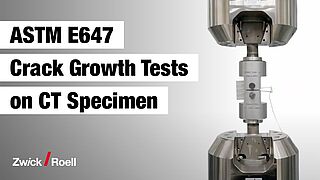ASTM E647 crack growth da/dN and threshold value ΔKth
The crack growth da/dN and the threshold value ΔKth to ASTM E647 are fracture mechanics material values determined with cyclic loading at constant amplitude.
Crack growth curve Region I & Region II Video Threshold value ΔKth Crack growth da/dNParis curve Software Testing machines Additional information
Crack growth curve
The crack growth of a material is described in the crack growth curve. This curve is divided into three regions:
- Region I: low crack growth rate; threshold value ΔKth value at which crack growth is just beginning
- Region II: constant crack growth rate; is mathematically described with the Paris curve, fatigue crack growth da/dN
- Region III: high crack growth rate; ends with fracture, critical stress intensity factor K1C
Regions I and II of the crack growth curve
The ASTM E647 standard for determination of the threshold value ΔKth and the fatigue crack growth da/dN addresses regions I and II of the crack growth curve. The crack growth to ASTM E647 is mainly determined for ductile materials. Here, a differentiation is made between the threshold value ΔKth (region I) and the fatigue crack growth da/dN (region II).
Crack growth test to ASTM E647
The crack growth test to ASTM E647 is performed on CT specimens, for which a HA 250 kN servohydraulic testing machine is used. The determined characteristic values are the crack growth da/dN and the threshold value ΔKth.
Threshold value ΔKth (region I) to ASTM E647
To determine the threshold value ΔKth to ASTM E647, loads in the crack initiation region or higher are applied to the specimen at the beginning of the test. The rate of the crack growth is slowed down more and more by continuing to reduce the load amplitude. At the beginning, the crack grows fairly quickly and towards the end of the test, the crack growth continues to slow down until the crack stops or until at least a crack velocity da/dN of 10-7 mm/load change is reached. Once this point has been reached, the ΔKth can be determined. With this method, the threshold value ΔKth (region I) and the Paris curve (region II) can be determined.
The ASTM E647 standard describes two methods for the threshold determination:
a) Testing at constant stress ratio R
For methods with constant stress ratio, both the maximum and the minimum stress intensity are lowered to reduce the cyclic stress intensity.
To avoid lag effects due to reduction of the load with increasing crack length, the increments must be selected appropriately. The ASTM E647 standards allows for both incremental and continuous lowering. When lowering incrementally, the forces (P) are constant within each increment. This leads to a short-term increase in stress intensity due to the growing crack until the load is reduced again. Therefore, according to ASTM E647, the step height is not to exceed 10% of the respective higher load, or the width of the steps must be at least 0.5 mm.
b) Testing at constant maximum stress intensity
In addition to methods in which the R ratio is kept constant, the ASTM E647 standard also allows a method with constant maximum stress intensity factor. In this method of threshold determination, starting from a high cyclic stress intensity factor, the minimum stress intensity is continuously increased until the threshold value is reached.
Crack growth da/dN to ASTM E647 (region II)
To determine stable crack growth da/dN to ASTM E647 while maintaining the load amplitude, the Fmax and Fmin are kept constant throughout the entire test process. Due to the decreasing load-bearing cross-section and the resulting increasing stress intensity on the crack tip, the crack propagation accelerates.
This investigation method can be used to determine the general crack growth curve (region II) and the Paris curve. Determination of the threshold value ΔKth is not possible.
What is the Paris curve?
The center region (region II) of the crack growth curve is designated as the Paris curve.
The constant increase of the crack length per load change (da/dN) in relation to the cyclic stress intensity factor dK is designated as the crack growth curve. In the center region (region II), the crack growth curve can be described mathematically with the simple Paris law equation:
Da/dN = C*(ΔK)m
This region is also referred to as the Paris curve, because here the stable crack growth means that the curve has a constant slope when plotted logarithmically.
Related products: Software
A special test program is available for testXpert Research for the determination of crack growth in regions I and II to ASTM E647.
With this test program, both pre-cracking and the determination of the crack growth curve can be carried out.
With the use of different types of loads, the threshold value ΔKth, the crack growth da/dN and the Paris curve can be determined automatically.
Related products: testing machines
Testing machines with different drive concepts for static tests, dynamic tests and crack generation are available for crack growth determination.
Vibrophores can be used for crack generation and for the performance of tests to ASTM E647. The testing system is based on a spring-mass system, that is set into vibration in a magnetic field and thus generates a dynamic load. A static preload is applied via an integrated electromechanical drive.
